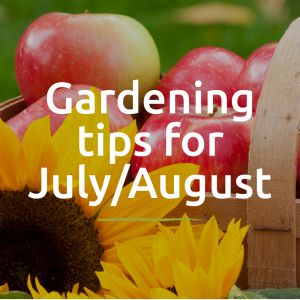29th July 2022
Gardening Tips for July/August
Hot, hot, hot!
August is often the hottest month of the year, but July has been hot, hot, hot!
Feeding and watering plants and crops is a top priority over the next two months as we see temperatures soar.
Using grey water and making the most of the forecasted rainy spells by filling water butts, watering cans and any containers you have to store water, will help with tackling drought.
With more hot weather on its way, make the most of the longer days by gardening early morning or into the late evening sun. Whilst we don’t want to see the summer go so soon, now is the ideal time to be thinking of autumn and winter planting.
Enjoy the blooming flowers, the delicious crops that will be ready to pick and your garden in general, we’re in for a hot summer!
Time for picking!
• It’s time to pick soft fruits such as strawberries, nectarines, apricots, and peaches.
• Apple, pear, and plum trees heavy with fruit will need to be thinned out to improve the crop. Remove those that are damaged or overgrown. You can keep these for juicing or cider!
• If you’ve grown courgettes, harvest before they become marrows.
• Continue to cut raspberry canes.
• Lift and pot up strawberry runners once they have finished fruiting.
• Water all crops, however some are thirstier than others. Peas, celery, pumpkins, and tomatoes tend to drink more water. Add a good, all round liquid feed such as Vitax Organic All Purpose Plant Food to help give them extra growing power.
• As the tops wilt and die down on onions and shallots, lift and store in a cool, dry place.
• Continue to sow fast growing salad leaves on a regular basis to maintain supply.
• Now is the ideal time to sow ready for autumn harvest. Beans such as French and Runner beans are ideal. Sow radish and beetroot.
• If you are growing tomato plants, continue to pinch outside side shoots and feed with Vitax Organic Tomato Food.
• It’s time! Turnips can now be planted as well as planting out winter cabbages, cauliflowers, sprouting broccoli and leeks.
• Cover brassicas and newly planted vegetables to prevent birds and cabbage white butterflies damaging crops.
Maintaining your blooms:
• Use a quick acting summer feed on your plants to give them a boost and maintain flowering. Q4 All Purpose Liquid Feed is ideal.
• Support tall perennials such as gladioli and lupins with canes or posts.
• As we head into late summer, prune wisteria.
• Continue to deadhead bedding plants, dahlias and repeat flowering perennials. Trim lavender.
• Bring the outdoors in with cut flowers to encourage flower buds to open. Houseplants such as primroses and begonias will also produce flowers for cutting.
• Agapanthuses are real showstoppers and will flower in July through to early autumn. Feed with a high potash fertiliser or Organic Liquid Seaweed during the growing season.
• Autumn bulbs such as nerines and crocuses can be planted now.
• As flowers go to seed, collect the seeds of those you wish to sow next season.
• Cut back hanging baskets as soon as the flowers finish and give the remaining plants a good feed with Tub & Hanging Basket Feed.
• The warmer months will distress plants if not regularly fed and watered and can lead to disease. Keep a careful watch for powdery mildew.
• Inspect chrysanthemums for white rust and roses for black spot. Protect against black spot and other diseases such as powdery mildew with Vitax Rose Guard Rose Tonic.
• Mulch borders to help retain moisture and ward off weeds!
• Prepare winter pots and containers.
Weeds & Pests
• Weed as you go to keep them at bay. The warm weather may slow down growth but as soon as the rain comes, they will flourish.
• The warm, wet weather will also see a resurgence of slugs and snails. Keep them at bay with Slug Gone, which not only provides a continual barrier around the plants but will help retain moisture.
• Check plants in pots for vine weevil.
• Watch out for aphids, especially on runner and broad bean plants. Either physically remove or use a preventative spray such as Organic Plant Guard.
Other gardening jobs
• Open greenhouse vents and doors for ventilation and water the floor to add more moisture as the weather remains hot.
• Turn compost bins and add garden waste.
• Clean bird baths and feeders with Greenhouse Disinfectant to prevent the spread of disease. Keep them regularly topped up.
• Lawns may turn yellow during drought but will green back up when watered. Use Green Up Enhance Liquid Lawn Feed to reduce grass stress.
Although there is plenty to do in the garden, there will be days where it is just too warm. It is these days you can sit back and relax, plan for autumn and winter and enjoy the fruits of your labour with fresh produce and freshly cut flowers.
Your login details have been used by another user or machine. Login details can only be used once at any one time so you have therefore automatically been logged out. Please contact your sites administrator if you believe this other user or machine has unauthorised access.














